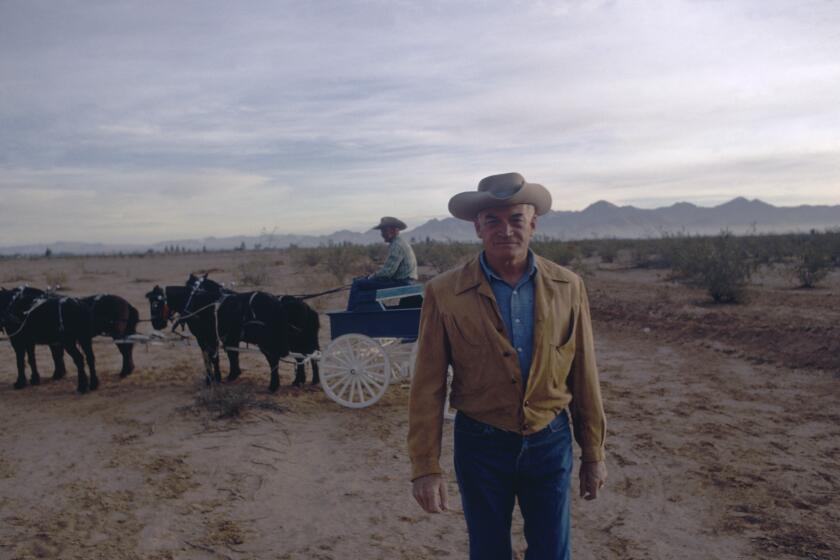Opinion: Is Arizona’s abortion ban a return to the 19th century? No, it’s actually worse

- Share via
Arizona’s Supreme Court opened a new front in the war on women’s reproductive rights last week when it resurrected an obscure 1864 law that bans abortion in almost all cases. Critics of the ruling say the court has thrown Arizona back into the 19th century.
That isn’t entirely fair to the 19th century.
The irony of last week’s reactionary ruling is that the author of the original law, William T. Howell, was a progressive by the standards of his time. The politics of Arizona’s current justices bear little resemblance to the 19th century antecedent upon whom their ruling relies.
Although many of Howell’s views have aged poorly, he argued against the era’s prevailing patriarchal dogma and in favor of women’s property rights. Even his abortion law was guided by concerns about maternal health, not the right-wing, religious orthodoxy that animates much of the antiabortion movement today.
Voters in our state may repeal the ban, so I’m anticipating the November election with hope and fear in equal measure.
If 19th century legal precedent is important, so is historical context. As today’s lawyers and politicians battle over the future of abortion rights, they should understand how and why the original Arizona law came to be. The statute emerged from the upheaval of the Civil War and its little-known front in the West.
As a history professor and the author of a book on this subject, I never expected Howell to become a posthumous standard-bearer for the modern American right. If he’s known at all, it’s as an agent of Abraham Lincoln’s campaign to stamp out slavery in the Southwest and secure Union control of the region.
That story began in the spring of 1861, when a band of migrants from neighboring Texas seized power in southern New Mexico. Proclaiming their affinity for the slave-holding South, they broke from the Union and threw their allegiance behind the newly formed Confederacy. They named their new rebel territory “Arizona.”
Cowboying has virtually disappeared in the state, but Western attire has a new purpose: to broadcast right-leaning ideology.
Several months later, the Confederacy launched its first invasion of the war — into the Southwest. The rebel invaders routed U.S. troops in several battles, secured military control over Arizona and seized Santa Fe, New Mexico’s capital. Then they planned to march on the gold fields of California.
They never made it. In the spring of 1862, Union troops sabotaged the Confederates’ supplies and finally sent them scrambling back to Texas.
Congress then divided the region into a western half (Arizona) and an eastern half (New Mexico), splitting the erstwhile Confederate Arizona Territory. To strengthen the Union’s tenuous hold, Lincoln poured federal troops and agents into the region. One of them was Howell, newly appointed as an associate justice of Arizona’s territorial Supreme Court.
A veteran jurist and former Michigan legislator, Howell got to work on a new code of laws for Arizona. The final document, now known as the Howell Code, ran to nearly 500 pages. One of its primary purposes was to ensure that slavery would never again take root in Arizona.
Buried within it was the now-infamous abortion ban. The provision was no outlier. In fact, it was copied from California’s legal code, one of many such laws passed by states and territories in the 1860s and ’70s.
From the colonial era into the early 19th century, abortions had been commonly administered and rarely criminalized. Benjamin Franklin even included a recipe for an abortifacient in a math textbook, of all places. Abortions before “quickening” — within roughly the first four or five months of pregnancy — were considered “the purview of women” rather than the law, according to the historian Sarah Handley-Cousins. Even the Catholic Church “implicitly accepted” abortions before quickening, the historian Leslie J. Reagan has noted.
The Howell Code, then, marked a departure from a more permissive approach to abortion. Even so, the antiabortion laws of the mid-19th century were generally born of a sincere concern for women’s health that is absent from today’s legislation. Tellingly, Arizona’s original antiabortion clause appeared within a provision on poisoning. The underlying premise was that abortions posed health risks to women, who were seen as victims and not held legally liable for the medical procedures performed on them.
Howell himself had a woman’s health on his mind at the time. Shortly after drafting the code, he rushed back to Michigan to be at the bedside of his ill wife. She survived, and Howell remained in Michigan, never seeing his code put into practice.
The judge had previously defended women’s right to property in their own name rather than subsumed under her husband’s. He also advocated free public schools and opposed capital punishment (though executions were allowed for certain crimes under the Howell Code).
Howell is no progressive poster child by today’s standards. He was in many ways a man of his time. And his code, written hastily in his provisional courtroom — an adobe shack adjoining a horse corral — reflected some of the prevailing prejudices of the early American frontier, imposing numerous restrictions on people who weren’t white.
But Howell is nevertheless an awkward antecedent for today’s antiabortion movement. If Arizona’s 21st century Supreme Court justices wish to exhume an obscure 19th century predecessor from the recesses of history, that’s their prerogative. But they should understand that even he is misaligned with their extreme politics.
Kevin Waite is an associate professor of history at Durham University and the author of “West of Slavery: The Southern Dream of a Transcontinental Empire.”
More to Read
A cure for the common opinion
Get thought-provoking perspectives with our weekly newsletter.
You may occasionally receive promotional content from the Los Angeles Times.












